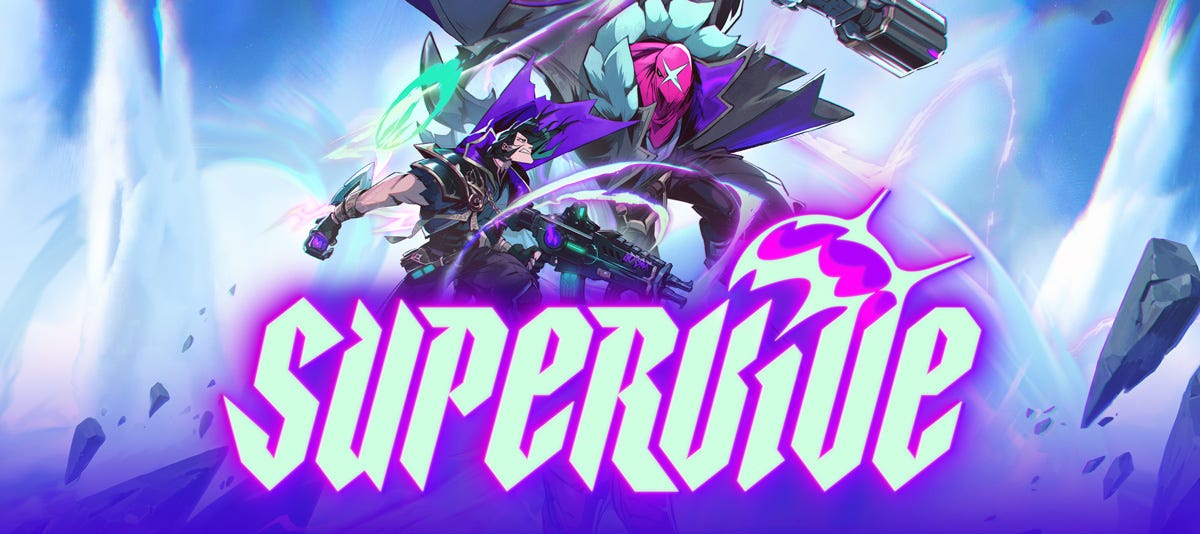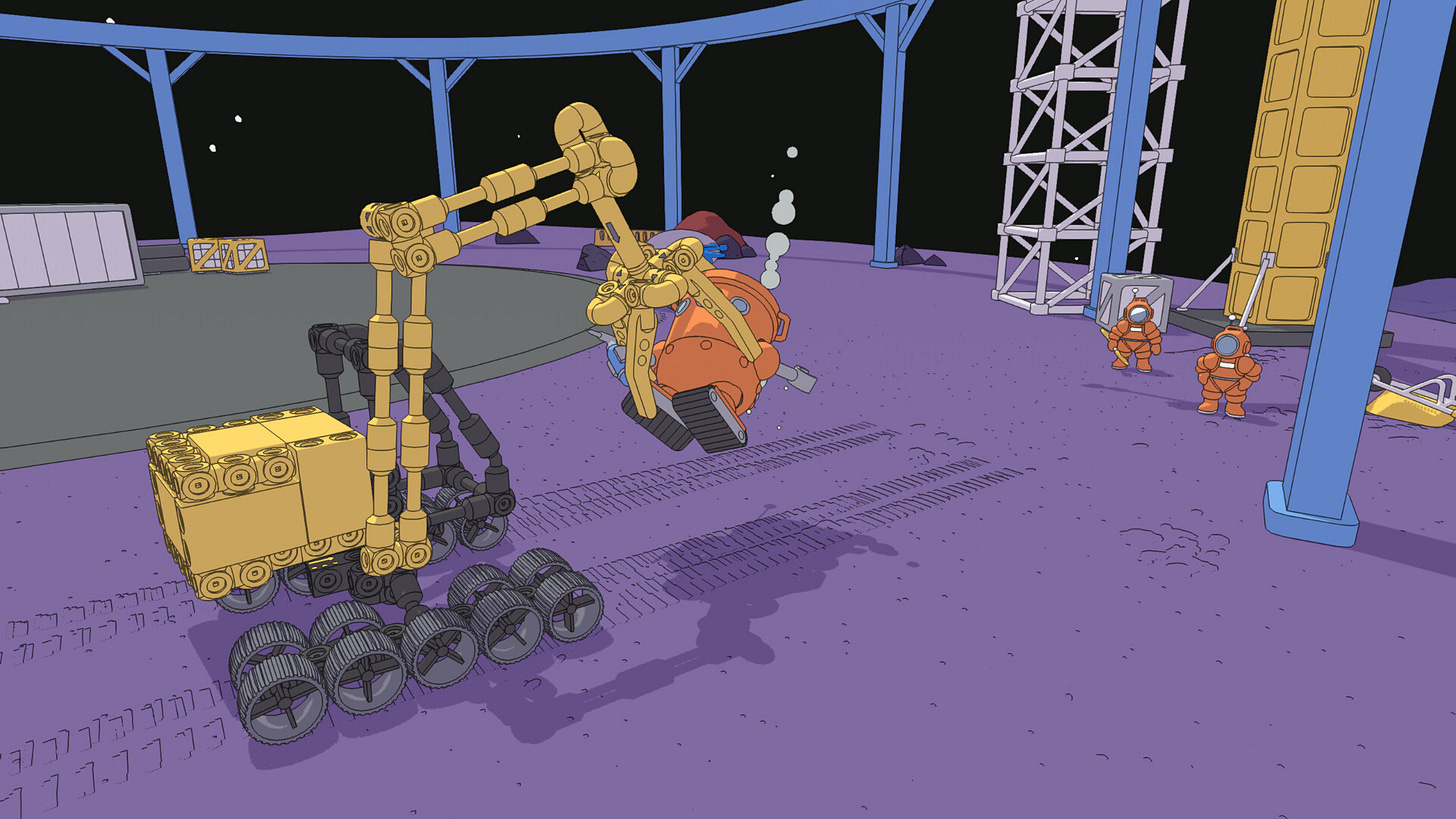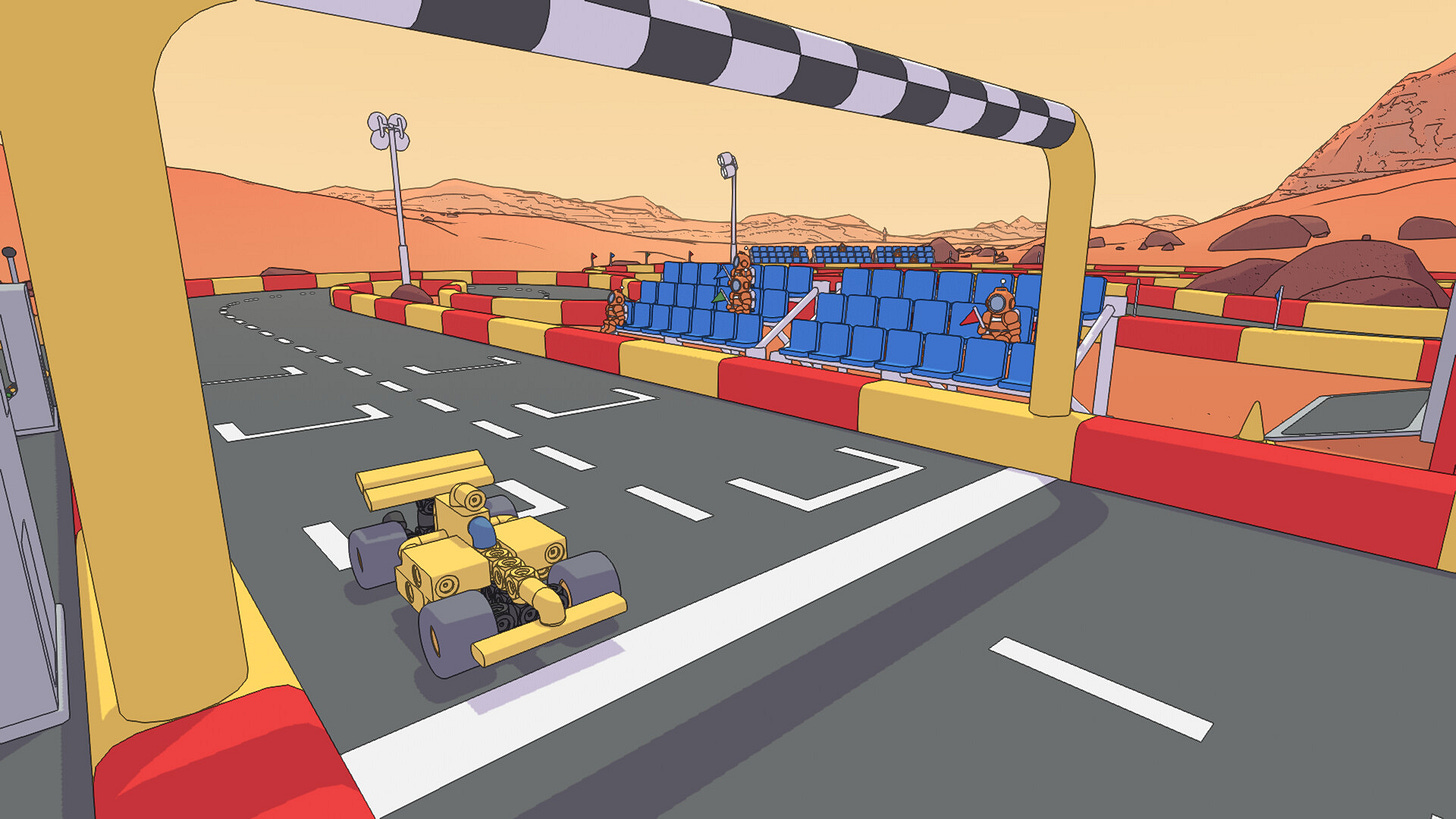After Releasing 50 Games, This Australian Dev Headed to Mars
push to talk #26 // how ian maclarty broke through an invisible wall in red dead redemption 2 and ended up on the red planet
I buy two or three Steam games every week with the excuse that I’m doing “market research.”
Games are long and time is short, so I usually dip into each for only an hour or so—just long enough to see what the devs are cookin’. Then onto the next one.
Mars First Logistics is different. It sucked me in.
The game—which is in Early Access on Steam—is a gorgeous, meditative physics puzzler about building vehicles to move awkwardly-shaped objects (a bag with a live fish in it, a box of apples, etc.) dozens of kilometers across the rocky surface of the red planet. I’m obsessed with it.
So this week I reached out to the game’s creator, Australian-based dev Ian MacLarty for an interview.
That story is below. But first, this week’s spiciest games industry news links:
Scuttlebutt and Slackery
The week’s most-shared, oft-Slacked, and spiciest games industry news links.
Theorycraft Games Reveals SUPERVIVE - Of all the gaming startups that raised big during the investor feeding frenzy of 2020, Theorycraft is the team with the most impressive pedigree. Joe Tung and gang have been cooking for years on the “neon-apocalyptic” battle royale game SUPERVIVE, formerly known as Project Loki, and it looks insanely fun. This week they’re taking signups for their first large-scale playtests, and player reactions so far look really promising. (Theorycraft on YouTube)
How tinyBuild Earned 3 Million Steam Wishlists - Anyone trying to sell PC games needs to read this blog post from Alex Nichiporchik, CEO of PC gaming publisher tinyBuild. In it, he shares some really useful insight into their strategy for getting lots of attention and wishlists for the games in their portfolio, some of which—like Kingmakers and Streets of Rogue 2— are among the most-wishlisted on Steam. (tinyBuild.com)
Chained Together Hooks (And Shackles) Streamers - It’s rare for new game genres to emerge, so it’s funny to see the term “Foddylike” emerge—a reference to designer Bennett Foddy’s frustrating games like Getting Over It, which challenge players with intentionally awkward control schemes. Chained Together is the latest in a wave of Foddylikes, and like many before (Only Up, The Game of Sisyphus) it’s crushing it with streamers. (Steam)
Starfield’s 20-Minute, $7 Bounty Hunter Quest Draws Players’ Ire - In a world of $500 optional cosmetics, you might not expect much controversy around a $7 DLC that actually adds story-based content to a game, but you’d be wrong—Starfield players are incensed about the newest DLC. As one Redditor wrote: “If they priced a $10 gun and armor it would be ignored. It shows it isn’t just about price, it's about consumer expectations.” (Kotaku)
After Releasing 50 Games, This Australian Dev Headed to Mars
I’m just going to confess something up front: that “50 games” headline is kind of clickbait.
It’s technically true that over the last 15 years, Australian game developer Ian MacLarty has released 51 games, all of which are catalogued on his website.1 But many of these projects are only tangentially gamelike. Many are more like interactive screensavers, drug-induced hallucinations, or even visual reconstructions of MacLarty’s dreams.
This is to say, this guy is a game developer, but he’s also an artist playing around with the possibilities of games as an art form.
Don’t get it twisted, though—MacLarty has released a ton of traditional games, including some really excellent puzzlers. After making his first mobile games in 2010, MacLarty had his first true hit with Boson X, which he made with a friend in 2013. That was a tipping point in his career.
“It did quite well and I was lucky enough to be able to reduce my days at my regular job and spend more time on my games,” MacLarty says. “I ended up making a lot of smaller, non-commercial, more experimental games including Catacombs of Solaris, which was well received. In 2017 I decided to go full time and released Dissembler with the help of some local government funding. It received regular featuring on the App Store and did well for me. In 2019 I released Jumpgrid which did less well commercially,2 although it won a lot of awards.”
In between his full time game dev work, in 2019 MacLarty and a small group of friends began hanging out together in the online mode for Red Dead Redemption 2. First they were just goofing around and taking pictures of each other using the game’s built in photo mode, but soon they making a hobby out of exploring the outer reaches of the game’s expansive world.
The crew eventually discovered a glitchy area that allowed them to break outside of RDR2’s intended map, and their forays into the bizarre, glitchy landscapes outside the boundaries turned into an obsession—one that was later documented in an extremely charming mini-documentary called The Grannies.
MacLarty was so taken by the otherworldly experiences he’d had while breaking RDR2 that he began working on a game inspired by it.
Red Desert Render was the result—an open-world exploration game for which MacLarty developed a unique generative terrain system.
Using the foundations from Red Desert Render, MacLarty began to explore other game ideas based around the generative terrain system. After some experiments, he landed on a prototype for a vehicle-building game which would ultimately become Mars First Logistics, and formally announced the game in 2021.
“After the announcement I got a lot of interest from publishers,” MacLarty says, “although I wasn't specifically looking for a publisher at the time. I had enough savings to make it on my own. I did speak to several publishers, but none of them really appealed. Either the terms were too one-sided, or it seemed like there'd be a lot of admin or stressful deadlines.
That changed, MacLarty says, when he was contacted by the team setting up what would later become Outersloth, the indie game fund founded by Among Us creators Innersloth. “It just seemed like a really good fit for me,” MacLarty says. “Good terms, nice people and the space and resources to really push the game beyond what I could've done on my own.”
As a result of the funding from his deal with Outersloth, MacLarty has since been able to bring on a small team of collaborators to help make Mars First Logistics. Together, MacLarty and his team have been steadily releasing updates on Steam, where the game enjoys an “overwhelmingly positive” review average.
Read the rest of the Push to Talk Q&A with Ian MacLarty below:
PUSH TO TALK: I'm curious about the inspirations behind Mars First Logistics. I detect a good bit of Banjo-Kazooie: Nuts & Bolts but I know there are probably plenty of other games in the "chaotic physics vehicle builder" genre that I haven't played.
IAN MACLARTY: To be honest I hadn't heard of Banjo-Kazooie: Nuts & Bolts until people started comparing it to MFL. The idea for MFL came from wanting to do more with the generative terrain system I'd developed for Red Desert Render. Having the player transport awkwardly shaped items from A to B over that landscape, seemed like a good way to make it a kind of central antagonist. And then the idea to have the player build their own vehicles came out of that.
Playing Death Stranding crystalized a lot of these ideas and, importantly, validated the idea that delivering stuff over a hostile landscape can make a fun game! I also wanted to make something that felt earnest in its execution and not just a haha-physics kind of game, even if it was still funny. I didn't want to make a "clown" that was trying hard to be funny, if that makes sense.
I LOVE the art style for MFL. Can you talk a bit about how you landed on it, and how it works on a technical level?
Thank you! The look is inspired by a combination of Tintin comics and Lego instruction manuals. I grew up with Tintin, so there's a bit of nostalgia there, but the simultaneously playful, yet clear and technical feeling of the visuals really suit the game too. Plus it was relatively easy to make 3D models for, since there are no textures.
I did a whole thread on the rendering. It's based on standard edge detection, but with a few small innovations like pre-computing "surface ids" for the models instead of using the normals.3
Something that strikes me about MFL's art style is that it feels timeless, like it'll still look appealing 20 years from now. And very few 3D games (whether indie-made or AAA) could achieve that even as recently as ten years ago, but increasingly I'm seeing 3D indie games that have this quality—like you wouldn't want them to look any other way. It seems like as an art form games are starting to become more about "art style" than "graphics," in that sense. I wonder if you have any thoughts on this topic?
Dan Golding4 once told me that he thought games were currently in a "baroque" period. I think this makes a lot of sense, at least for AAA games that have the budgets to make the lush, dense, detailed, colorful worlds they do.
But it is just a style and styles come and go. I'm not really sure if there's such a thing as a timeless style. It's very hard to recognize the hallmarks of a period when you're in it. I do agree that indies, partly by necessity, and partly because they're less constrained, are experimenting more with visual styles and being more deliberate in how they use them to evoke a certain feeling.
I also can't help feeling that the hardware-driven race to photo realism will soon run its course. The gains seem to be smaller and smaller, but the costs are rising sharply. It doesn't seem sustainable.
You've talked about how you see the landscape being sort of the main character in MFL, and really it is a game about navigating alien topography. To my untrained eye it also looks pretty true to the real Martian landscape—how concerned were you about "accuracy" of the game's map? And more broadly, could you say more about your interest in Mars?
It's nice to hear you say it looks like Mars! My intention was to give the feeling of Mars certainly, and I looked at many references (both real and fictional) when devising the terrain generation, but I was more concerned about it giving the impression of Mars than being true to the actual Martian landscape.
It was more important that the landscape be fun to navigate with both visual and pacing variety. I think it's nice to have to stop and think about how you're going to get round/over an obstacle every now and then, but I didn't want journeys to be a big slog either.
I've always been interested in Mars, and space in general. I remember when I was a child, we had a national geographic with a 3D picture of Mars from one of the early rovers (the magazine came with some 3D glasses—the kind with green and red lenses), and I was fascinated with that. Just the idea that this was a photo of a real alien planet and how strangely familiar it looked.
I wouldn't say I'm super into Mars at this stage in my life though. The reason the game is set on Mars is pretty mundane: It was originally a small commission funded by a pandemic related arts grant and for some reason they asked us if we could theme the game around a color. I got red, so I decided to set it on Mars. Plus the Martian landscape is pretty barren, so I thought it would be easier to render (no trees!).
You've made so many experimental games and projects before MFL, and now you've been committed to it for a while. What do you hope to achieve with it? When will it be "done?"
As to what I hope to achieve with MFL and when it will be "done," I'm taking that as it comes. I think it's important that we continue to enjoy working on it, and while that is still the case I don't see myself working on it forever.
It has certainly been the biggest game I've worked on by far, and being a somewhat sandboxy, open-ended game, it's a great vessel for new ideas, so it doesn't really feel like I've stopped making lots of smaller games, it's just that they've all become parts of this one big game.
Games like this tend to do really well with word-of-mouth marketing because players can inspire each other with their creations. I'm wondering if you have a sense of where most of your players find you?
This was certainly a point that informed the design of the game and I added Steam workshop support early on. I also set up a Discord and players often share their creations there and I'm regularly astounded by both the mechanical complexity and beauty of the things people make.
The Discord and Steam forums are the main ways I communicate with my players at the moment. I don't really use Twitter/X much any more outside of big announcements. I did have quite a bit of fun posting on Tiktok, especially leading up to the Early Access release of the game, with good results, but I do find it hard to "switch gears" between making promotional content and working on the game.
I'd much rather just be working on the game most of the time. And I think that's fine for where I am right now. We're currently working on a fairly meaty update and I'll put my promo hat back on when that gets closer to release.
That’s it for this week. I’m gonna venture into the most toxic gaming subreddit I can find and spend hours defending the honor of Banjo-Kazooie: Nuts & Bolts.
See you next Friday.
Scroll all the way to the bottom of MacLarty’s portfolio site for an insanely trippy visual effect.
I really highly recommend Jumpgrid—easily one of the sleekest, most satisfying mobile puzzle games I’ve played in years.
In 2022 MacLarty and Kalonica Quigley, the 3D artist on Mars First Logistics, did a presentation about the process of developing the look for MFL. The video and audio quality isn’t great but it’s a fun watch, particularly for the audience’s reactions to the game.











